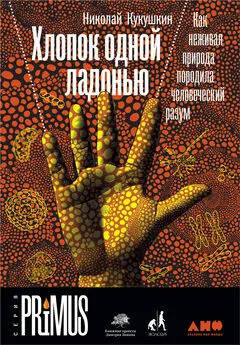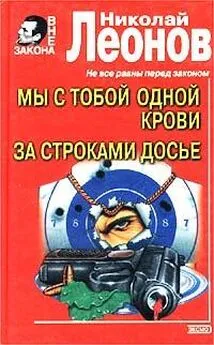Николай Кукушкин - Хлопок одной ладонью
- Название:Хлопок одной ладонью
- Автор:
- Жанр:
- Издательство:Альпина нон-фикшн
- Год:2020
- Город:Москва
- ISBN:978-5-0013-9315-3
- Рейтинг:
- Избранное:Добавить в избранное
-
Отзывы:
-
Ваша оценка:
Николай Кукушкин - Хлопок одной ладонью краткое содержание
Оказывается, в человеческом страдании виноваты динозавры, легкие существуют благодаря лишайникам, а главным событием в жизни наших предков за последний эон было превращение в червей. «Хлопок одной ладонью» – это история человека и его внутреннего мира, вмещающая в себя весь путь от неорганических молекул до возникновения языка и рассказанная так, будто это рыцарский роман или мифический эпос.
Хлопок одной ладонью - читать онлайн бесплатно ознакомительный отрывок
Интервал:
Закладка:
52. Huttenlocker, A. K. Body size reductions in nonmammalian eutheriodont therapsids (Synapsida) during the end-Permian mass extinction. PLoS One 9, e87553, doi:10.1371/journal.pone.0087553 (2014).
53. Abdala, F. Galesaurid cynodonts from the Early Triassic of South Africa: Another example of conflicting distribution of characters in non-mammalian cynodonts. South African Journal of Science 99, 95–96 (2003).
54. Schmidt-Nielsen, K. & Randall, D. J. Animal Physiology: Adaptation and Environment (Cambridge University Press, 1997).
55. Tucker, V. A. Respiratory Physiology of House Sparrows in Relation to High-Altitude Flight. Journal of Experimental Biology 48, 55 (1968).
56. Farmer, C. G. The Evolution of Unidirectional Pulmonary Airflow. Physiology (Bethesda) 30, 260–272, doi:10.1152/physiol.00056.2014 (2015).
57. Farmer, C. G. & Sanders, K. Unidirectional airflow in the lungs of alligators. Science 327, 338–340, doi:10.1126/science.1180219 (2010).
58. Schachner, E. R., Cieri, R. L., Butler, J. P. & Farmer, C. G. Unidirectional pulmonary airflow patterns in the savannah monitor lizard. Nature 506, 367–370, doi:10.1038/nature12871 (2014).
59. Cieri, R. L., Craven, B. A., Schachner, E. R. & Farmer, C. G. New insight into the evolution of the vertebrate respiratory system and the discovery of unidirectional airflow in iguana lungs. Proc Natl Acad Sci USA 111, 17218–17223, doi:10.1073/pnas.1405088111 (2014).
60. Farmer, C. G. Similarity of Crocodilian and Avian Lungs Indicates Unidirectional Flow Is Ancestral for Archosaurs. Integr Comp Biol 55, 962–971, doi:10.1093/icb/icv078 (2015).
61. Erickson, G. M., Rogers, K. C. & Yerby, S. A. Dinosaurian growth patterns and rapid avian growth rates. Nature 412, 429–433, doi:10.1038/35086558 (2001).
62. Gerkema, M. P., Davies, W. I., Foster, R. G., Menaker, M. & Hut, R. A. The nocturnal bottleneck and the evolution of activity patterns in mammals. Proc Biol Sci 280, 20130508, doi:10.1098/rspb.2013.0508 (2013).
63. Charles-Dominique, P. in Phylogeny of the Primates: A Multidisciplinary Approach (eds W. Patrick Luckett & Frederick S. Szalay) 69–88 (Springer US, 1975).
64. Heesy, C. P. & Hall, M. I. The nocturnal bottleneck and the evolution of mammalian vision. Brain Behav Evol 75, 195–203, doi:10.1159/000314278 (2010).
65. Seebacher, F. Dinosaur body temperatures: the occurrence of endothermy and ectothermy. Paleobiology 29, 105–122, doi:10.1666/0094–8373 (2003) 029<0105: DBTTOO>2.0. CO; 2 (2003).
66. Benton, M. J. Ectothermy and the Success of Dinosaurs. Evolution 33, 983–997, doi:10.2307/2407661 (1979).
67. Hillenius, W. J. Turbinates in Therapsids: Evidence for Late Permian Origins of Mammalian Endothermy. Evolution 48, 207–229, doi:10.1111/j.1558–5646.1994.tb01308.x (1994).
68. McNab, B. K. The Evolution of Endothermy in the Phylogeny of Mammals. The American Naturalist 112, 1–21, doi:10.1086/283249 (1978).
69. Bennett, A. F. & Ruben, J. A. Endothermy and activity in vertebrates. Science 206, 649–654, doi:10.1126/science.493968 (1979).
70. Edelman, I. S. Transition from the polikilotherm to the homeotherm: possible role of sodium transport and thyroid hormone. Fed Proc 35, 2180–2184 (1976).
71. Else, P. L., Windmill, D. J. & Markus, V. Molecular activity of sodium pumps in endotherms and ectotherms. Am J Physiol 271, R1287–1294, doi:10.1152/ajpregu.1996.271.5. R1287 (1996).
72. Hughes, D. A., Jastroch, M., Stoneking, M. & Klingenspor, M. Molecular evolution of UCP1 and the evolutionary history of mammalian non-shivering thermogenesis. BMC Evol Biol 9, 4, doi:10.1186/1471-2148-9-4 (2009).
73. Virtanen, K. A. BAT thermogenesis: Linking shivering to exercise. Cell Metab 19, 352–354, doi:10.1016/j.cmet.2014.02.013 (2014).
74. Lee, P. et al. Irisin and FGF21 are cold-induced endocrine activators of brown fat function in humans. Cell Metab 19, 302–309, doi:10.1016/j.cmet.2013.12.017 (2014).
75. Zhang, W. et al. Irisin: A myokine with locomotor activity. Neurosci Lett 595, 7–11, doi:10.1016/j.neulet.2015.03.069 (2015).
76. Xiong, X. Q. et al. FNDC5 overexpression and irisin ameliorate glucose/lipid metabolic derangements and enhance lipolysis in obesity. Biochim Biophys Acta 1852, 1867–1875, doi:10.1016/j.bbadis.2015.06.017 (2015).
77. Kring, D. et al. Chicxulub and the Exploration of Large Peak-Ring Impact Craters through Scientific Drilling. GSA Today 27, doi:10.1130/GSATG352A.1 (2017).
78. Morgan, J. V. et al. The formation of peak rings in large impact craters. Science 354, 878–882, doi:10.1126/science.aah6561 (2016).
79. Ohno, S. et al. Production of sulphate-rich vapour during the Chicxulub impact and implications for ocean acidification. Nature Geoscience 7, 279–282, doi:10.1038/ngeo2095 (2014).
80. Robertson, D. S., McKenna, M. C., Toon, O. B., Hope, S. & Lillegraven, J. A. Survival in the first hours of the Cenozoic. GSA Bulletin 116, 760–768, doi:10.1130/B25402.1 (2004).
81. Pope, K. O., Baines, K. H., Ocampo, A. C. & Ivanov, B. A. Impact winter and the Cretaceous/Tertiary extinctions: Results of a Chicxulub asteroid impact model. Earth and Planetary Science Letters 128, 719–725, doi: https://doi.org/10.1016/0012-821X (94) 90186–4(1994).
82. Belcher, C. M. Reigniting the Cretaceous-Palaeogene firestorm debate. Geology 37, 1147–1148, doi:10.1130/focus122009.1 (2009).
83. Farmer, C. G. Parental Care: The Key to Understanding Endothermy and Other Convergent Features in Birds and Mammals. Am Nat 155, 326–334, doi:10.1086/303323 (2000).
84. Grigg, G. C., Beard, L. A. & Augee, M. L. The evolution of endothermy and its diversity in mammals and birds. Physiol Biochem Zool 77, 982–997, doi:10.1086/425188 (2004).
1. Ben-Ami Bartal, I., Decety, J. & Mason, P. Empathy and pro-social behavior in rats. Science 334, 1427–1430, doi:10.1126/science.1210789 (2011).
2. Wechkin, S., Masserman, J. H. & Terris, W. Shock to a conspecific as an aversive stimulus. Psychonomic Science 1, 47–48, doi:10.3758/BF03342783 (1964).
3. Esaias, W. E. & Curl Jr, H. C. Effect of dinoflagellate bioluminescence on copepod ingestion rates. Limnology and Oceanography 17, 901–906, doi:10.4319/lo.1972.17.6.0901 (1972).
4. Seyfarth, R. M. & Cheney, D. L. Affiliation, empathy, and the origins of theory of mind. Proc Natl Acad Sci USA 110 Suppl 2, 10349–10356, doi:10.1073/pnas.1301223110 (2013).
5. Brosnan, S. F. & De Waal, F. B. Monkeys reject unequal pay. Nature 425, 297–299, doi:10.1038/nature01963 (2003).
6. Wernicke's Aphasia , < https://www.youtube.com/watch?v=dWBfgJ-VLOg>
7. Wernicke's aphasia , < https://www.youtube.com/watch?v=dKTdMV6cOZw>
8. Gallese, V. & Goldman, A. Mirror neurons and the simulation theory of mind-reading. Trends in Cognitive Sciences 2, 493–501, doi: https://doi.org/10.1016/S1364–6613 (98) 01262–5(1998).
9. Michael, J. et al. Continuous theta-burst stimulation demonstrates a causal role of premotor homunculus in action understanding. Psychol Sci 25, 963–972, doi:10.1177/0956797613520608 (2014).
10. Keysers, C. & Gazzola, V. Expanding the mirror: vicarious activity for actions, emotions, and sensations. Curr Opin Neurobiol 19, 666–671, doi:10.1016/j.conb.2009.10.006 (2009).
11. Keysers, C. & Gazzola, V. Hebbian learning and predictive mirror neurons for actions, sensations and emotions. Philos Trans R Soc Lond B Biol Sci 369, 20130175, doi:10.1098/rstb.2013.0175 (2014).
12. Botha-Brink, J. & Modesto, S. P. A mixed-age classed 'pelycosaur' aggregation from South Africa: earliest evidence of parental care in amniotes? Proc Biol Sci 274, 2829–2834, doi:10.1098/rspb.2007.0803 (2007).
13. Jasinoski, S. C. & Abdala, F. Aggregations and parental care in the Early Triassic basal cynodonts Galesaurus planiceps and Thrinaxodon liorhinus. PeerJ 5, e2875, doi:10.7717/peerj.2875 (2017).
14. Schmidt-Nielsen, K. & Randall, D. J. Animal Physiology: Adaptation and Environment (Cambridge University Press, 1997).
15. Hopson, J. A. Endothermy, Small Size, and the Origin of Mammalian Reproduction. The American Naturalist 107, 446–452 (1973).
16. Broad, K. D., Curley, J. P. & Keverne, E. B. Mother-infant bonding and the evolution of mammalian social relationships. Philos Trans R Soc Lond B Biol Sci 361, 2199–2214, doi:10.1098/rstb.2006.1940 (2006).
17. Chen, Z. et al. Prolonged milk provisioning in a jumping spider. Science 362, 1052–1055, doi:10.1126/science.aat3692 (2018).
18. Attardo, G. M. et al. Analysis of milk gland structure and function in Glossina morsitans: milk protein production, symbiont populations and fecundity. J Insect Physiol 54, 1236–1242, doi:10.1016/j.jinsphys.2008.06.008 (2008).
19. Keverne, E. Biology and Pathology of Trophoblast (2006).
20. Crockford, C., Deschner, T., Ziegler, T. E. & Wittig, R. M. Endogenous peripheral oxytocin measures can give insight into the dynamics of social relationships: a review. Front Behav Neurosci 8, 68, doi:10.3389/fnbeh.2014.00068 (2014).
21. Nagasawa, M. et al. Social evolution. Oxytocin-gaze positive loop and the coevolution of human-dog bonds. Science 348, 333–336, doi:10.1126/science.1261022 (2015).
22. Ogawa, S., Kudo, S., Kitsunai, Y. & Fukuchi, S. Increase in oxytocin secretion at ejaculation in male. Clin Endocrinol (Oxf) 13, 95–97, doi:10.1111/j.1365–2265.1980.tb01027.x (1980).
23. Carmichael, M. S. et al. Plasma oxytocin increases in the human sexual response. J Clin Endocrinol Metab 64, 27–31, doi:10.1210/jcem-64-1-27 (1987).
24. Holt-Lunstad, J., Birmingham, W. A. & Light, K. C. Influence of a «warm touch» support enhancement intervention among married couples on ambulatory blood pressure, oxytocin, alpha amylase, and cortisol. Psychosom Med 70, 976–985, doi:10.1097/PSY.0b013e318187aef7 (2008).
25. Grewen, K. M., Girdler, S. S., Amico, J. & Light, K. C. Effects of partner support on resting oxytocin, cortisol, norepinephrine, and blood pressure before and after warm partner contact. Psychosom Med 67, 531–538, doi:10.1097/01.psy.0000170341.88395.47 (2005).
26. Feldman, R. Oxytocin and social affiliation in humans. Horm Behav 61, 380–391, doi:10.1016/j.yhbeh.2012.01.008 (2012).
27. Zak, P. J., Stanton, A. A. & Ahmadi, S. Oxytocin increases generosity in humans. PLoS One 2, e1128, doi:10.1371/journal.pone.0001128 (2007).
28. Kosfeld, M., Heinrichs, M., Zak, P. J., Fischbacher, U. & Fehr, E. Oxytocin increases trust in humans. Nature 435, 673–676, doi:10.1038/nature03701 (2005).
29. Domes, G., Heinrichs, M., Michel, A., Berger, C. & Herpertz, S. C. Oxytocin improves «mind-reading» in humans. Biol Psychiatry 61, 731–733, doi:10.1016/j.biopsych.2006.07.015 (2007).
30. Guastella, A. J. et al. Intranasal oxytocin improves emotion recognition for youth with autism spectrum disorders. Biol Psychiatry 67, 692–694, doi:10.1016/j.biopsych.2009.09.020 (2010).
31. Guastella, A. J., Mitchell, P. B. & Dadds, M. R. Oxytocin increases gaze to the eye region of human faces. Biol Psychiatry 63, 3–5, doi:10.1016/j.biopsych.2007.06.026 (2008).
Читать дальшеИнтервал:
Закладка:



![Василий Звягинцев - Хлопок одной ладонью. Том 1. Игра на железной флейте без дырочек [OCR]](/books/213154/vasilij-zvyagincev-hlopok-odnoj-ladonyu-tom-1-igr.webp)
![Василий Звягинцев - Хлопок одной ладонью. Том 2. Битва при Рагнаради [OCR]](/books/213155/vasilij-zvyagincev-hlopok-odnoj-ladonyu-tom-2-bit.webp)




